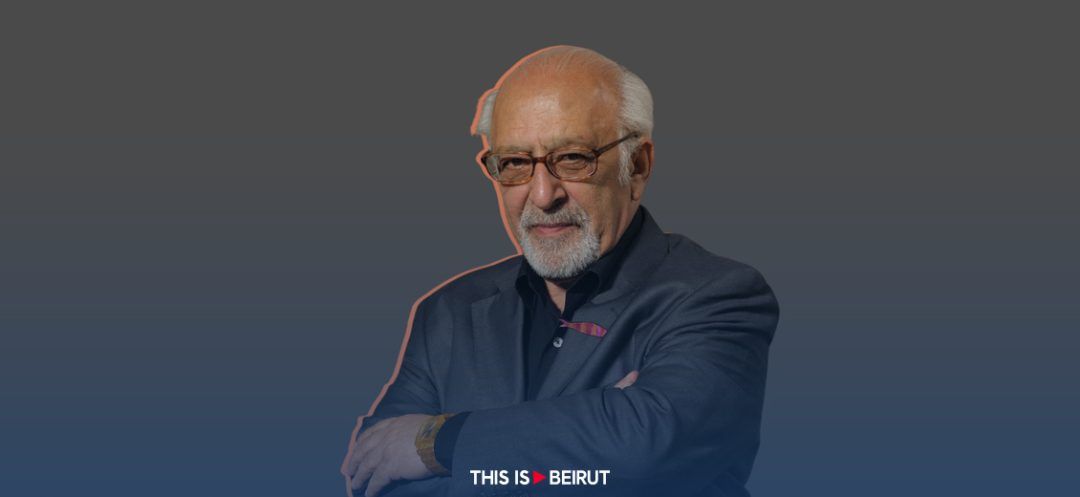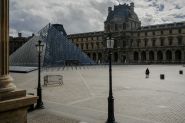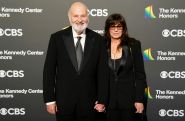
Waddah Faris, a distinguished figure in both Lebanese and regional art, has left an indelible legacy in the world of art and culture. He recently passed away at the age of 84. Renowned for his charisma and extraordinary personality, Faris not only significantly influenced local and Arab art scenes but also made a mark on the international stage.
A gallerist, graphic designer and multifaceted artist and the son of an Iraqi diplomat, Waddah Faris had a profound connection with Beirut, the city he dearly chose.
He is described as “larger than life” by Saleh Barakat, who regarded Faris as his mentor. These words reflect deep admiration and immense respect, underlining Faris’s significant impact on Barakat’s career and the establishment of his gallery, Agial, which drew inspiration from Faris’s “school.” Faris was described as an omnipresent figure in the country’s cultural life, pivotal in both its grand and humble moments. A close friend emotionally noted that his presence was felt in every facet of the cultural milieu, and his involvement extended far beyond mere participation. Faris played a crucial role in initiating various cultural initiatives and actively supporting the projects of others.
His zeal for art led him to co-found, with César Nammour, the Contact art gallery. This gallery transcended its primary exhibition function to become a haven for the Lebanese intelligentsia. The gallery hosted a diverse array of cultural events, including poetic evenings featuring notable figures like the esteemed poet Youssef El Khal and later, his ex-wife Helen El Khal, as well as various concerts and lectures.
Faris also maintained close relationships with the country’s artists, writers and poets. He went beyond mere acquaintanceship, offering tangible support by utilizing his graphic design skills and illustrating their works. His passion for art and culture was comprehensive, encompassing all fields, which demonstrated his deep commitment and love for the arts in their entirety.
In 1980, he inaugurated the Faris Gallery in Paris, which rapidly gained recognition as an international hub for Arab art. The first gallerist to showcase Arab artists at major events like FIAC and Art Basel, he carved a path for these artists on the global stage.
Saleh Barakat recalls his first encounter with Faris in 1991. Their friendship stemmed from their mutual connections and was fueled by their shared dedication to Arab nationalism. Over time, this professional association blossomed into a deeper personal friendship.
Barakat highlights Faris’s contributions to Lebanese art, which span several decades, dating back to Lebanon’s “golden age” and manifesting through the Baalbek Festival, his gallery work and his graphic design contributions.
Known for his passion for photography, Faris captured various moments and personalities, preferring to retain the negatives without printing them. Barakat once discovered a box of accumulated photographic films at Faris’s place that captured the pivotal moments and figures of Lebanon during its golden age. These unprinted photos led to the creation, in 2017, of the exhibition Beirut, The City of the World's Desire: The Chronicles of Waddah Faris (1960–1975), in homage to Lebanon’s rich cultural heritage.
Faris’s memorable personality, characterized by his theatrical, deep and commanding voice, left a lasting impression. Myriam Ramadan, who knew him since her childhood, recalls how his voice profoundly affected her, both awe-inspiring and intimidating. She humorously remarked during an interview for Officiel, “Do you remember how your voice affected me? That impressionable child is now interviewing you!”
Despite establishing his family near Barcelona, Faris always maintained a deep connection with Beirut.
Saleh Barakat, who last saw Faris in 2020, affirms that Beirut remained his beloved homeland until his passing.
The death of Waddah Faris at the age of 84 signifies the conclusion of a pivotal era in the history of Lebanese and Arab art. His enduring legacy continues through his art, his gallery and the numerous individuals he influenced and inspired. Barakat poignantly notes, “His versatility and talent have made a lasting impact on the local, Arab and international art scenes.”
A gallerist, graphic designer and multifaceted artist and the son of an Iraqi diplomat, Waddah Faris had a profound connection with Beirut, the city he dearly chose.
He is described as “larger than life” by Saleh Barakat, who regarded Faris as his mentor. These words reflect deep admiration and immense respect, underlining Faris’s significant impact on Barakat’s career and the establishment of his gallery, Agial, which drew inspiration from Faris’s “school.” Faris was described as an omnipresent figure in the country’s cultural life, pivotal in both its grand and humble moments. A close friend emotionally noted that his presence was felt in every facet of the cultural milieu, and his involvement extended far beyond mere participation. Faris played a crucial role in initiating various cultural initiatives and actively supporting the projects of others.
His zeal for art led him to co-found, with César Nammour, the Contact art gallery. This gallery transcended its primary exhibition function to become a haven for the Lebanese intelligentsia. The gallery hosted a diverse array of cultural events, including poetic evenings featuring notable figures like the esteemed poet Youssef El Khal and later, his ex-wife Helen El Khal, as well as various concerts and lectures.
Faris also maintained close relationships with the country’s artists, writers and poets. He went beyond mere acquaintanceship, offering tangible support by utilizing his graphic design skills and illustrating their works. His passion for art and culture was comprehensive, encompassing all fields, which demonstrated his deep commitment and love for the arts in their entirety.
In 1980, he inaugurated the Faris Gallery in Paris, which rapidly gained recognition as an international hub for Arab art. The first gallerist to showcase Arab artists at major events like FIAC and Art Basel, he carved a path for these artists on the global stage.
Saleh Barakat recalls his first encounter with Faris in 1991. Their friendship stemmed from their mutual connections and was fueled by their shared dedication to Arab nationalism. Over time, this professional association blossomed into a deeper personal friendship.
Barakat highlights Faris’s contributions to Lebanese art, which span several decades, dating back to Lebanon’s “golden age” and manifesting through the Baalbek Festival, his gallery work and his graphic design contributions.
Known for his passion for photography, Faris captured various moments and personalities, preferring to retain the negatives without printing them. Barakat once discovered a box of accumulated photographic films at Faris’s place that captured the pivotal moments and figures of Lebanon during its golden age. These unprinted photos led to the creation, in 2017, of the exhibition Beirut, The City of the World's Desire: The Chronicles of Waddah Faris (1960–1975), in homage to Lebanon’s rich cultural heritage.
Faris’s memorable personality, characterized by his theatrical, deep and commanding voice, left a lasting impression. Myriam Ramadan, who knew him since her childhood, recalls how his voice profoundly affected her, both awe-inspiring and intimidating. She humorously remarked during an interview for Officiel, “Do you remember how your voice affected me? That impressionable child is now interviewing you!”
Despite establishing his family near Barcelona, Faris always maintained a deep connection with Beirut.
Saleh Barakat, who last saw Faris in 2020, affirms that Beirut remained his beloved homeland until his passing.
The death of Waddah Faris at the age of 84 signifies the conclusion of a pivotal era in the history of Lebanese and Arab art. His enduring legacy continues through his art, his gallery and the numerous individuals he influenced and inspired. Barakat poignantly notes, “His versatility and talent have made a lasting impact on the local, Arab and international art scenes.”
Read more




Comments